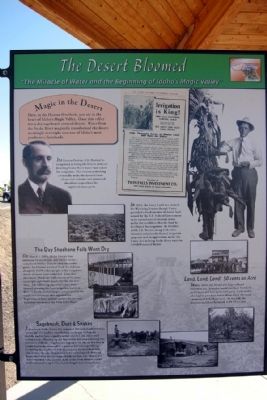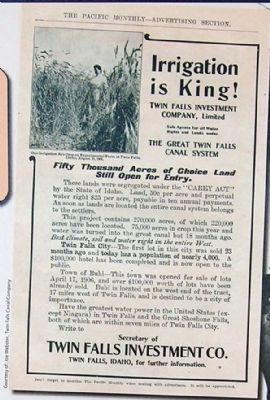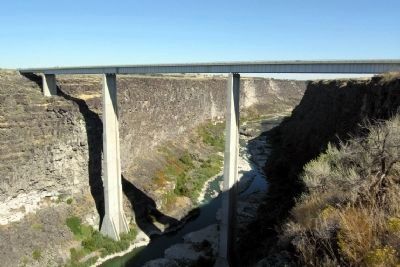Near Hansen in Twin Falls County, Idaho — The American West (Mountains)
The Desert Bloomed
"The Miracle of Water and the Beginning of Idaho's Magic Valley"
Magic in the Desert
Here, at the Hansen Overlook, you are in the heart of Idaho's Magic Valley. Once this valley was a dry sagebrush covered desert. Water from the Snake River magically transformed the desert seemingly overnight into one of Idaho's most productive farmlands.
Ira Burton Perrine (I.B. Perrine) is recognized as being the first to propose diverting Snake River water into canals for irrigation. His visionary thinking eventually made the desert bloom where rich volcanic soil produced abundant crops where dry sagebrush once grew.
In 1894, the Carey Land Act, named for Wyoming Senator Joseph Carey, provided a fixed amount of desert land owned by the U.S. Federal Government to be turned over to western states under the condition that the land be developed for irrigation. In October 1900, I.B. Perrine along with other investors submitted a formal irrigation proposal and an application under the Carey Act to bring Snake River water to 248,000 acres of land.
The Day Shoshone Falls Went Dry
On March 1, 1905, Idaho history was recorded when officials met on the newly completed Milner Dam to close the outlet gates. Ira Perrine watched from the sideline alongside 2,000 other people as his irrigation dream of many years unfolded. Late that afternoon, Shoshone Falls, thirty miles away, in an epic sight went nearly dry for the first time. The following day, canal gates were opened allowing the first irrigation water to flow. A bottle of champagne was poured in the canal in a ceremony that signaled the beginning of hope and prosperity for the new land that was named the Twin Falls Tract.
Sagebrush, Dust & Snakes
A provision in the Carey Act required the early landowners to "prove up" the land by establishing residence within six months and to have a small portion cleared and cultivated within a year. Proving up the land ready for crop planting was extremely difficult. Sagebrush ranging from one to five feet in height had to be removed in a process known as grubbing. Grubbing the sagebrush and clearing the land pushed dust clouds into the air. Dishes had to be stored upside down in homes that were merely tents, shacks or lean-tos. Water was scarce and had to be carried many miles from distant creeks. And rattlesnakes up to five-feet in length were everywhere.
Land, Land, Land! 50 cents an Acre
In July 1903, the Twin Falls Tract offered 60,000 acres. A settler could purchase farmland at 50 cents per acre up to 160 acres. Each settler also had to purchase water shares from the canal company at $25.00 per acre. In the end, the settlers could buy farmland at $3.25 an acre.
Topics. This historical marker
is listed in these topic lists: Agriculture • Settlements & Settlers. A significant historical date for this entry is March 1, 1905.
Location. 42° 33.957′ N, 114° 18.069′ W. Marker is near Hansen, Idaho, in Twin Falls County. Marker can be reached from State Highway 50, 0.3 miles north of County Road E3900N, on the left when traveling north. Marker may be accessed from the parking lot at the Hansen Overlook at the southwest end of the Hansen Bridge. Touch for map. Marker is in this post office area: Hansen ID 83334, United States of America. Touch for directions.
Other nearby markers. At least 8 other markers are within 4 miles of this marker, measured as the crow flies. Ancient Lake Bonneville (here, next to this marker); Hansen Bridge (within shouting distance of this marker); Rock Creek Station (approx. 2.3 miles away); Hansen (approx. 2.3 miles away); First Trading Post (approx. 2.3 miles away); Snake River Canyon Gold Rush (approx. 3.3 miles away); Before there were potatoes, there was GOLD (approx. 3.3 miles away); History Through the Eyes of a Camera (approx. 3.3 miles away). Touch for a list and map of all markers in Hansen.
More about this marker. Marker is part of the Thousand Springs Scenic Byway.
Credits. This page was last revised on June 16, 2016. It was originally submitted on November 28, 2013, by Duane Hall of Abilene, Texas. This page has been viewed 572 times since then and 23 times this year. Photos: 1, 2. submitted on November 28, 2013, by Duane Hall of Abilene, Texas. 3. submitted on December 25, 2012, by Duane Hall of Abilene, Texas.
Editor’s want-list for this marker. Wide-view photo of marker and its surroundings. • Can you help?


